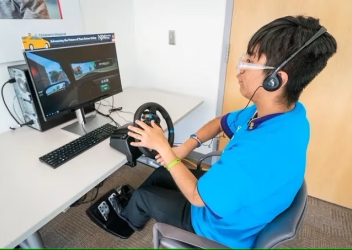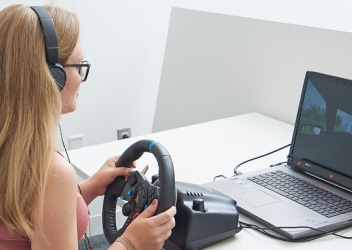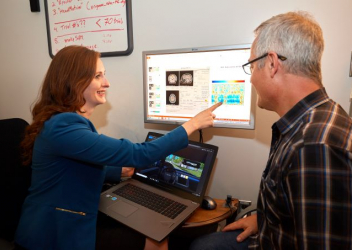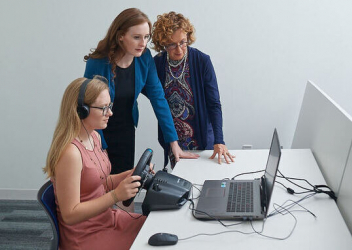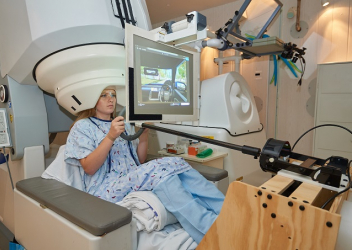Neuroscience of Driving Program
The Neuroscience of Driving Program at CIRP is helping to advance the science through the study of ongoing development of the brain and cognitive function during adolescence. Researchers are learning that this time of development may impact the ability of young drivers to attend to the road and drive safely. However, to date very little is known about the neural components of driving.
Everyday driving is a complex behavior that requires integrated brain function across sensory, motor and cognitive systems. This allows the driver to control the vehicle, have good situational awareness, manage distractions, and make quick decisions and respond rapidly in critical moments to avoid crashing.
The field of neuroscience has traditionally relied on the use of simplified tasks of isolated brain functions, such as pressing a button in response to a visual or auditory cue (or both) following a pre-established rule, but these tasks do not capture the brain's ability to handle complex real-world tasks like driving that rely on the integration of information from multiple systems in the brain (visual, motor, and cognitive systems).
To bridge basic neuroscience with applied driving research at the clinical and broader population level, the Young Driver Safety researchers at CIRP recently established the Neuroscience of Driving Program in partnership with the Annenberg Public Policy Center at the University of Pennsylvania and the neuroradiology Magnetoencephalography (MEG) Imaging Center at Children's Hospital of Philadelphia. This innovative partnership helped the research team establish a novel paradigm of simultaneous whole cortex MEG neuroimaging and eye-tracking recording during simulated driving. Researchers can now track eye movements and brain responses, second-by-second, while participants and patients are driving.
The long-term goal of the Neuroscience of Driving Program is to identify the neural mechanisms underlying driver errors so that novel interventions can be developed to improve driver safety. In addition, this program aims to develop simulated driving as a probe of complex integrated brain function. This would allow us to use driving (a complex, highly relevant and high-risk task) to investigate typical and atypical neural and cognitive development in adolescents.
Research Projects
- Executive Function Capacities, Negative Driving Behavior and Crashes in Young Drivers
Motor vehicle crashes remain a leading cause of injury and death in adolescents, with teen drivers three times more likely to be in a fatal crash when compared to adults. One potential contributing risk factor is the ongoing development of executive functioning with maturation of the frontal lobe through adolescence and into early adulthood. Atypical development resulting in poor or impaired executive functioning, as in Attention-Deficit/Hyperactivity Disorder, has been associated with risky driving and crash outcomes. However, executive function broadly encompasses a number of capacities and domains, including working memory, inhibition and set-shifting.
In this scientific review of the literature for measuring executive control and driving outcomes, the researchers highlight which specific abilities are most important to safe driving as adolescents continue to mature. Given the key role that executive function plays in safe driving, this review points also points to an urgent need for systematic research to inform development of more effective training and interventions for young drivers.
Principal Investigators: Elizabeth Walshe, PhD, Dan Romer, PhD, Flaura K. Winston, MD, PhD
Funding: Annenberg Public Policy Center; CHOP Research Institute
Read the study abstract.
Read a blog post about the research.
- Working Memory Development and Motor Vehicle Crashes in Young Drivers
This study, published in JAMA Network Open, is the first longitudinal study of working memory development in relation to vehicle crashes. Working memory -- a frontal lobe process associated with complex, moment-to-moment tasks essential to driving -- develops through adolescence and into the 20s.The researchers examined data from 118 youth in Philadelphia who were part of a larger groups that participated in a six-wave survey from when they were 10- to 12-year-olds in 2005 to when they were 18-to 20-year-olds in 2013-14. The survey measured working memory development, as well as associated risk-related traits and behaviors. The group later participated in a follow-up survey on driving experience.
Results suggest that a relatively slower rate of working memory development is associated with young driver crashes. The study authors believe that routine assessment of working memory across adolescence may help to identify at-risk teen drivers and opportunities for providing adaptive interventions, such as driving aids or training, that can help to address limitations in working memory-related skills that are critical to safe driving.
Principal Investigators: Elizabeth A. Walshe, PhD, Dan Romer, PhD
Funding: U.S. National Institute on Drug Abuse; Annenberg Public Policy Center; CHOP Research Institute
Read the study abstract.
Read a press release about the research .
Read a blog post about the research.
- Examining Virtual Driving Test Performance and Its Relationship to Individuals with HIV-Associated Neurocognitive Disorders
This study, published in Frontiers in Neuroscience, evaluated whether virtual driving assessment (VDA) variables were associated with a HIV-associated neurocognitive disorders (HAND) diagnosis. Existing screening tools for HAND are often clinically impractical for detecting milder forms of impairment, and the findings from this study show that the VDA shows promise in the development of a new screening paradigm for HAND. It was found to be clinically feasible and ecologically valid as an assessment of cognitive function. Additional research is needed to develop and validate a HAND screening model that incorporates the final subset of VDA variables identified in this study.
Principal Investigator: David Grethlein, MS
Funding: National Institute of Mental Health
Read the study abstract.
- Magnetoencephalography Neuroimaging During Simulated Driving: A New Paradigm for Driver Assessment
This study established a new paradigm for assessing drivers and for probing neurocognitive functioning in healthy and clinical populations. Our researchers have established a way to record whole cortex brain responses, using magnetoencephalographic (MEG) recording, while participants undergo an ecologically-relevant simulated driving experience of graded complexity.
A pilot experiment set out to demonstrate that expected motor cortex responses could be recorded clearly for basic driving-related movements, such as the hands for steering and the feet for pedal use. Further study established that additional frontal lobe cognitive control neural responses could be recorded as driving task demands increased. The research team then added eye-tracking recording to this paradigm so that eye movements can be tracked with brain responses and driving performance.
This paradigm can be used to:
- identify the neural mechanisms underlying driver recognition and decision errors (the most common errors leading to crashes)
- measure the impact of assistive and alert/warning technologies on these mechanisms
- use the simulated driving task as a more ecologically-valid probe of complex cognitive-motor function needed for real-world tasks in both typically developing and atypically developing or impaired populations
Principal Investigators: Elizabeth A. Walshe, PhD, Timothy Roberts, PhD, William Gaetz, PhD, Thomas Seacrist, MBE
Funding: Children's Hospital of Philadelphia Research Institute Foerderer Award
Read the study.
- An Event-Based Magnetoencephalography Study of Simulated Driving: Establishing a Novel Paradigm to Probe the Dynamic Interplay of Executive and Motor Function
This study aimed to establish a novel paradigm for the field by combining magnetoencephalography (MEG) and frequency-specific differential beamformer methods with an event-based simulated driving scenario. Validated in a pilot sample of healthy young drivers (age 16-23), the paradigm allows for the characterization of brain activity in space, time, and frequency. This approach offers a path forward for better understanding of integrated cognitive-motor processes and more real-world motor tasks, in typically developing and clinical populations. It also addresses a gap in the study of motor cortical rhythms.
Principal Investigators: Elizabeth A. Walshe, PhD; Timothy Roberts, PhD; Chesea Ward McIntosh, MS, CCRP; Dan Romer, PhD; Flaura Winston, MD, PhD; William Gaetz, PhD
Funding: National Institutes of Health; Children's Hospital of Philadelphia Research Institute Foerderer Award; Center for Child Injury Prevention Studies (CChIPS); Center for Injury Research and Prevention at CHOP; Annenberg Public Policy Center; University of Pennsylvania
Read the study.
Read a blog post about the research.
Watch a video about our research predicting crash risk in young drivers:





